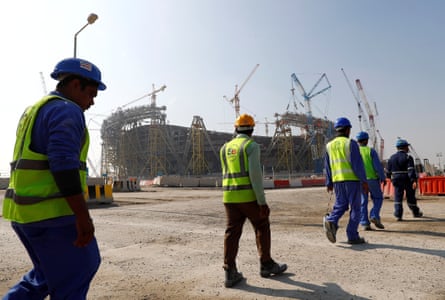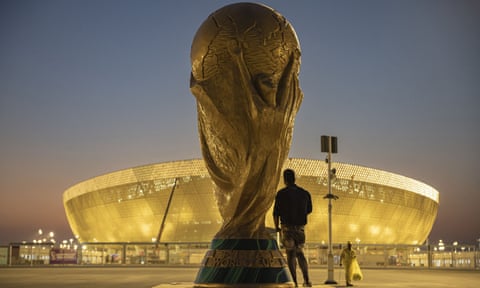As 32 teams gather in Qatar for this most unsettling of World Cups, the following numbers serve as a stark reminder of the human cost of the tournament, as well as the ongoing suffering among migrant workers, women and the LGBTQ+ community in the country.
Gianni Infantino, Fifa’s president, wants us to focus solely on football. Many will. But the World Cup’s impact should not only be measured on the balance sheet or the tournament’s roll of honour, but in the realities of ordinary people’s lives. These are just some of the numbers that shame Qatar’s shiny new stadiums and the 22nd edition of the World Cup:
$200bn
Amount Qatar is reported to have spent on getting the World Cup ready, compared with around $11bn spent by Russia in 2018.
0
Number of human rights clauses or conditions concerning labour protections requested by Fifa of the Qatari authorities when awarding hosting rights in 2010.
3
Official number of worker deaths during World Cup 2022 preparations, according to the Qataris and Infantino. Nicholas McGeehan of human rights organisation Fair Square calls that number a “wilful attempt to mislead” as it focuses on projects that account for only 1% of construction in Qatar. The Supreme Committee says that a further 36 workers from stadium sites also died, but for “non-work” reasons – ie, they died after a day’s work due to “natural causes”.
Quick GuideQatar: beyond the football
Show

It was a World Cup like no other. For the last 12 years the Guardian has been reporting on the issues surrounding Qatar 2022, from corruption and human rights abuses to the treatment of migrant workers and discriminatory laws. The best of our journalism is gathered on our dedicated Qatar: Beyond the Football home page for those who want to go deeper into the issues beyond the pitch.
Guardian reporting goes far beyond what happens on the pitch. Support our investigative journalism today.
???
The exact number of migrant workers who have died as a result of negligence on projects linked to the World Cup. The real number will never be known. According to Human Rights Watch “Qatari authorities have failed to investigate the causes of deaths of thousands of migrant workers, many of which are attributed to ‘natural causes’.” HRW also found that, in such cases, families seldom receive compensation for deaths because, under Qatari labour law, deaths not considered work-related are not entitled to compensation.
6,500
Migrant workers from India, Pakistan, Nepal, Bangladesh and Sri Lanka reported by the Guardian to have died in Qatar between 2010, when it was awarded the tournament, and 2021.
200
Nepali worker deaths due to heat in Qatar, according to a 2019 study in the journal Cardiology that found a correlation, concluding that “as many as 200 of the 571 cardiovascular deaths [of Nepali workers] during 2009-17 could have been prevented” with effective heat protection measures. “We know workers are undergoing medical assessments before leaving their home countries and upon arrival,” says Isobel Archer, of the Business & Human Rights Resource Centre. “They’re deemed to be fit and healthy, yet we know there have been many, many deaths among previously fit and healthy young men on such a scale that it would be astonishing in any other context.”

100,000
Minimum figure for number of migrant workers Amnesty International consider to have been exploited and suffered abuse because of lax labour laws and insufficient access to justice in Qatar in the past 12 years.
14-18
Hours worked a day by many migrant workers in Qatar, particularly in the domestic and security sectors, according to Amnesty. A recent report by Equidem found many similar stories, including from a Kenyan worker who described working 14-hour days at the Lusail Stadium without paid overtime for more than two years.
£225
Legal minimum wage a month in Qatar (1,000 riyals), the equivalent of about £1 an hour, although food and accommodation are provided. In recent years, the authorities have introduced a number of labour reforms, including the introduction of a minimum wage and the abolition of the kafala, or sponsorship, system. However, human rights groups say it has been piecemeal and many abuses still take place.

1,300–3,000
Range in dollars paid as a recruitment fee by some migrant workers from India, Bangladesh, Nepal and elsewhere seeking work in Qatar. While this is now illegal, many workers are still struggling to repay their recruitment fees, and associated debts, and send money to their families.
119
Qatar’s rating, out of 180 countries, on the Reporters Without Borders press freedom index. That makes it one of the better countries in the region, however reporters have still been warned by human rights groups that they are likely to face surveillance at the World Cup.
7
Years in prison that men and women who have sexual relations outside marriage can face under 281 article of the penal code. HRW say this disproportionately affects women, who have been prosecuted if they report rape. It says “police often do not believe women who report such violence, instead believing the men who claim it was consensual, and any evidence or suggestion that a woman knew the male offender has been enough to prosecute the woman”.
11
Cases of ill-treatment in detention for lesbian, gay, bisexual, and transgender people between 2019 and 2022, according to a report by HRW in October 2022. It said that Qatar Preventive Security Department forces have arbitrarily arrested LGBT people and subjected them to ill-treatment in detention including six cases of “severe and repeated beatings and five cases of sexual harassment in police custody between 2019 and 2022”. As a requirement for their release, security forces mandated that transgender women detainees attend conversion therapy sessions at a government facility. According to the authorities, however, there are no gay “conversion” centres in Qatar.

5
Possible number of years’ imprisonment under article 296 of Qatar’s penal code for “leading, instigating or seducing a male in any way to commit sodomy or dissipation” and “inducing or seducing a male in any way to commit illegal or immoral actions”.
$440m
Amount Amnesty and others believe Fifa should make available to help compensate migrant workers who have died or suffered injury in Qatar. That is equivalent to the World Cup’s prize money. However, Qatar’s labour minister has rejected such proposals, claiming criticism of the government counts as “racist”. The minister, Ali bin Samikh al-Marri, told AFP there was “no criteria to establish these funds,” and asked: “Where are the victims? Do you have names of the victims? How can you get these numbers?”
